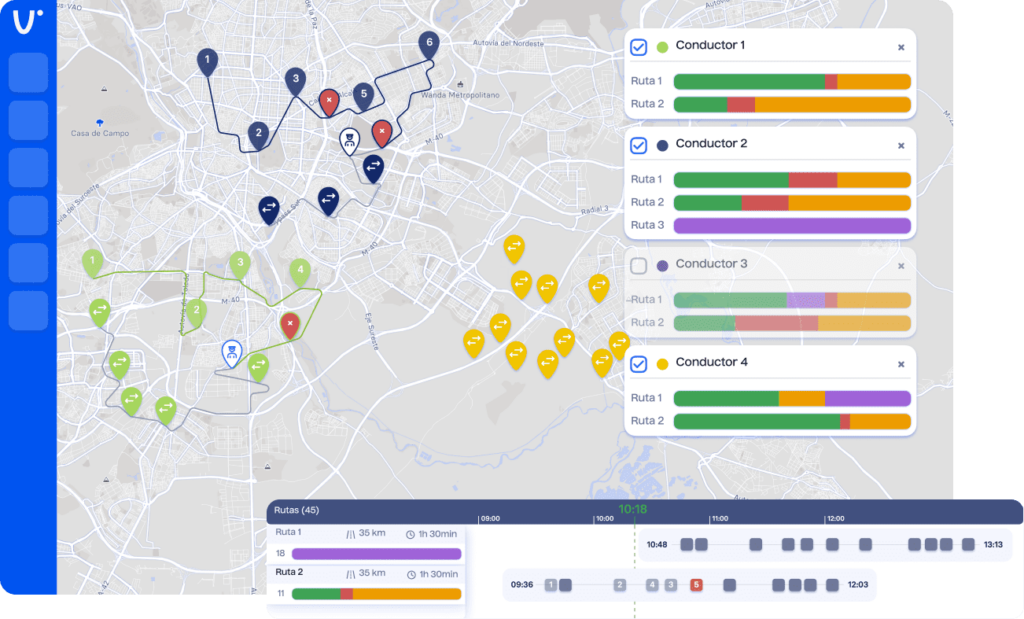La “telemática” es la unión de dos áreas de la tecnología: las telecomunicaciones y la informática. La telemática para gestión de flotas ofrece a las empresas de transporte una gran cantidad de datos sobre sus vehículos, todo ello a través de una red inalámbrica de alta velocidad.
Estos datos les indicarán cómo mejorar sus flotas, desde la gestión eficiente del combustible y la localización de vehículos, hasta la reducción de incidentes. No es de extrañar, por tanto, que cada vez haya más empresas que inviertan en sistemas telemáticos modernos.
En este artículo te explicamos cómo funciona la telemática para gestión de flotas, qué tipo de tecnologías utilizan y cómo se utilizan para mejorar la seguridad y la eficiencia operativa de estas.
¿Qué hace un sistema telemático para flotas?
Un sistema telemático para flotas permite enviar, recibir y almacenar los datos telemáticos de los vehículos para poder realizar diferentes tareas, como localizar un vehículo mediante señales GPS. Gracias al avance de las tecnologías telemáticas, estos sistemas son capaces de recoger una gran variedad de datos. A continuación, enumeramos algunas de las principales tecnologías telemáticas que se usan hoy en día y la tipología de datos que recoge cada una:
- Módulo de Control del Motor: Velocidad, kilometraje del vehículo, uso de los frenos, presión de aceite del motor y temperatura del motor.
- Seguimiento por GPS u otros sistemas de gestión de dispositivos móviles: Ubicación del vehículo en cualquier momento, velocidad y ubicación con respecto a la geocerca (cerca virtual o perímetro alrededor de una ubicación física).
- Cámaras de vídeo: Reacción y comportamiento del conductor inmediatamente antes y después de un incidente, condiciones de la carretera, comportamiento de otros vehículos y estado de la carga.
- Sistemas avanzados de asistencia al conductor (ADAS): Distancia de seguimiento, salida de carril y distancia en referencia a otros vehículos u objetos.
- Dispositivos electrónicos de registro: Fecha, hora, información de ubicación, horas de motor, kilometraje del vehículo e información de identificación del conductor.
Utilizar la telemática para gestión de flotas te ayudará a tomar decisiones basadas en datos comprobados.

Te proporcionará información sobre cómo mejorar la actividad de tus vehículos y realizar entregas más rápidas. En definitiva, te ayudará a mejorar tus operaciones, la seguridad de tus vehículos y la satisfacción del cliente.
Ventajas de la telemática
La telemática para gestión de flotas puede ayudar a estas a conseguir mejoras en áreas clave, en especial en las de operaciones y seguridad.
Beneficios operativos
- Gestión del combustible: Los sistemas telemáticos te ayudarán a identificar áreas de derroche de combustible, como el ralentí de los vehículos o las pérdidas puntuales, y te permitirán afrontarlas con rapidez. De esta forma, podrás ahorrar combustible y maximizar la eficiencia de los resultados.
- Elaboración de informes: La telemática para gestión de flotas integra los datos recogidos con otras aplicaciones empresariales, lo que te permitirá obtener una visión completa de las operaciones y te ayudará a tomar las decisiones más adecuadas. La elaboración de informes será de especial ayuda para la reducción de costes, teniendo en cuenta que el coste del transporte en carretera ha alcanzado máximos históricos.
- Mantenimiento de vehículos: Si quieres conocer el estado y la condición de tus vehículos, los sistemas telemáticos también te proporcionarán esa información. A través de datos como el kilometraje del vehículo o el tiempo de funcionamiento del motor, podrás crear programas de mantenimiento rigurosos y detallados, minimizando el tiempo de inactividad de cada vehículo.
- Seguimiento de las entregas: Gracias a las alertas electrónicas que te proporcionan los sistemas telemáticos, siempre conocerás la localización de tus paquetes junto a la hora y fecha prevista de entrega.
- Optimización de rutas: La telemática para gestión de flotas ha modernizado la calidad del servicio y la eficiencia de las flotas. Los sistemas telemáticos te permitirán optimizar las rutas de reparto con el fin de reducir kilometraje innecesario.
- Integridad y seguimiento de la carga: Los remolques y contenedores de transporte pueden ser rastreados incluso cuando están fuera de la carretera gracias a la telemática para gestión de flotas. Esto se traducirá en menos pérdidas o robos.
- Seguimiento remoto de la flota en tiempo real:
A través de los datos del sistema GPS a tiempo real, los conductores podrán evitar retrasos provocados por el tráfico y gestionar pequeños contratiempos.
Ante las incidencias, los gestores de la flota podrán mover la carga a otro vehículo más cercano y/o darles instrucciones sobre la ruta más eficiente para lograr entregar a tiempo.

- Satisfacción del cliente mediante una respuesta más rápida: Con la mejora de la eficiencia de las operaciones de la flota, la satisfacción de cliente se verá incrementada.
- Mejor gestión de los conductores: Al hacer un seguimiento de la hora exacta en que el vehículo se pone en marcha hasta que se detiene, dispondrás de un registro preciso y automatizado del tiempo que ha trabajado un conductor. Esto te permitirá verificar que los empleados reciban el pago exacto por las horas trabajadas.
Beneficios de seguridad
- Reducir los accidentes: El seguimiento a tiempo real del estado del vehículo mantiene a los conductores fuera de las carreteras cuando el automóvil no sea seguro de conducir. De esta forma, se tiene en cuenta la seguridad de todos, no solo la del conductor.
- Aumentar las medidas de seguridad: Al supervisar de cerca la actividad de los vehículos y las prácticas de conducción, podrás tomar decisiones oportunas sobre el tipo de programas de formación para tu flota. También sobre las directrices de conducción que puedes aplicar para asegurar el cumplimiento de la seguridad y las normas de tráfico que rige el gobierno.
- Reducir los comportamientos agresivos al volante: Las cámaras de vídeo permiten conocer el comportamiento de los conductores al volante y reducir los hábitos de conducción no deseados, como el exceso de velocidad o el frenado brusco.
Conclusión
Se prevé un crecimiento exponencial de la telemática para gestión de flotas a medida que se desarrollen nuevas aplicaciones que aprovechen las mejoras de los sistemas GPS y se proporcionen más ayudas para digitalizar el sector del transporte.
Es por eso, que cada vez son más las empresas que reconocen la necesidad de supervisar la actividad de sus flotas a través de estos sistemas para controlar los costes, impulsar la productividad y mejorar sus operaciones.



